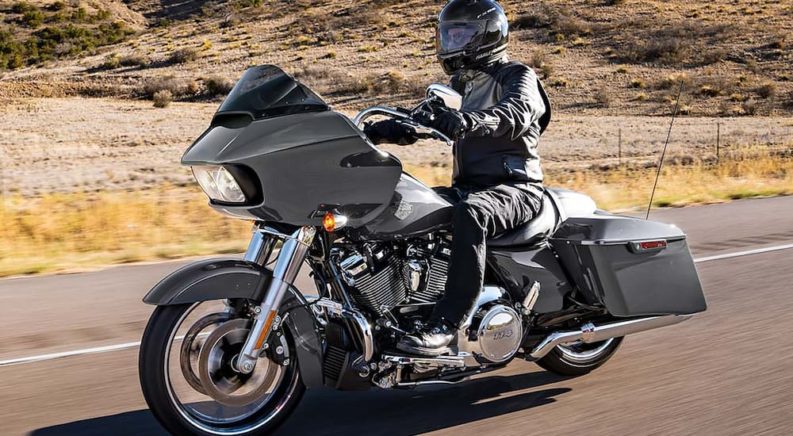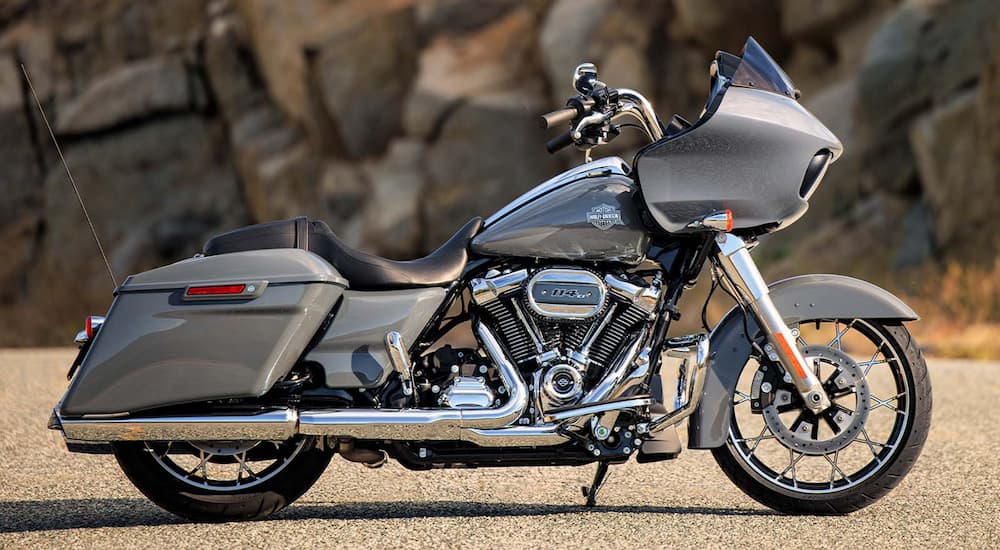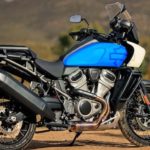The 2022 Harley-Davidson Road Glide Special was made for touring. First introduced back in 1979 as the Tour Glide, the popular model has become one of the go-to rides for those looking to do some long-distance riding. Part of Harley-Davidson’s Grand American Touring range that also includes the Street Glide, Electra Glide, Road King, and Ultra Limited, the Road Glide is the perfect companion for riders seeking the perfect long-haul sled. There are countless factors that make the Road Glide the ideal touring motorcycle, from its efficient Milwaukee-Eight engine and ample storage space to comfortable seating and a fixed fairing that go a long way in reducing rider fatigue at higher speeds. The Road Glide Special is actually just one of four Road Glide models on offer for the 2022 model year, with the Road Glide, Road Glide Limited, and performance-oriented Road Glide ST rounding out the lineup. But what exactly makes the Road Glide so perfect for touring? Let’s take a look at the history of this game-changing model and then dive into a few tips that’ll ensure your next motorcycle tour is a success.
Built for the Long Haul
The Tour Glide won early praise for a unique design feature that made it especially well-suited for cruising: a fixed fairing that went a long way in reducing fatigue on longer rides. Prior to the introduction of the Tour Glide, most motorcycles featured a fairing that was attached to the fork. That’s all fine and well when the motorcycle is pointed straight ahead, but as soon as a rider starts to turn the handlebars, the fairing moves in turn, dramatically increasing air resistance and forcing them to wrestle for control. This isn’t a big deal at lower speeds but can make a big difference on the highway, where this increased resistance can translate to as much as 60 pounds of force exerted on the handlebars.
The Tour Glide got around this age-old problem with a relatively simple solution: attaching the fairing to the frame instead of the handlebars. This allows riders to maneuver the motorcycle to the left or right without an increase in air resistance, making for a safer, more maneuverable, and less tiring ride. This reputation for comfort, combined with the impressive power of Harley’s 80 cubic-inch Shovelhead engine, spoke for itself, with riders quickly flocking to the Tour Glide and making the model an instant leader in the touring category. The Tour Glide continued to pile up the industry “firsts” over the next few decades as the first motorcycle to feature a five-speed transmission, three-point rubber-mounted engine, and more. Harley continued to tinker with the design until 1998, when the Tour Glide was sunsetted and replaced with its next evolution, the Road Glide.
The Road Glide took everything there was to love about the Tour Glide and gave it a makeover fit for the 21st century. The most notable upgrade would probably be the engine, with Harley opting to drop a Twin Cam 96 in the new model. The powertrain was refreshed again going into 2017 with the introduction of a Harley-Davidson Milwaukee-Eight engine. Representing the ninth generation of Harley’s legendary “big twin” engines, the Milwaukee-Eight takes its name from the fact that it features four valves per cylinder for a total of eight valves. This unique setup allows the Milwaukee-Eight to improve fuel economy and produce 10 percent more torque than previous models.
The engine was the result of some thorough market research on the part of Harley-Davidson, which interviewed over 1,000 riders in seven cities in an effort to build the ideal motor for touring. More power, less heat, and less vibration were the three most-cited factors, and Harley got right to work. Engineers increased the Milwaukee-Eight’s power without a reduction in range or fuel consumption––actually increasing them in some cases––but reducing the engine’s temperature was the brand’s true masterstroke. Harley was able to cool the engine’s exhaust gasses by 100 degrees by relocating the catalytic converter and redesigning the water cooling mechanism, allowing riders to enjoy longer trips without too much heat-related discomfort.
Addressing the vibration issue forced Harley to walk something of a tightrope when it came to satisfying customers. While less vibration undoubtedly results in a more comfortable ride, it also takes a bit of the edge off the motorcycle experience. People expect their Harleys to provide a throaty growl at the very least, so reducing vibration too much would risk disenfranchising those riders who can’t truly enjoy their ride unless they can feel their fillings coming loose. In the end, Harley decided to prioritize comfort over bone-rattling legacy, reducing vibration in the Milwaukee-Eight-equipped models by as much as 75 percent.
As we mentioned previously, the Road Glide Special is just one of four Road Glide models available in 2022, alongside the entry-level Road Glide, the Road Glide Limited, and high-performance Road Glide ST. So what exactly sets the Special apart? In a word, customization. The standard Road Glide comes in three available color options with a chrome finish, features a 107 cubic-inch Milwaukee-Eight engine, and can seat two passengers. The Road Glide ST sees a major upgrade in the engine department with the inclusion of a 117 cubic-inch model and has an upgraded suspension and higher rise that allow for a better lean angle, but falls a bit short in the customization department with only two color options. Then there’s the Road Glide Special. Available in 10 different color combinations with either a chrome or blacked-out finish, the Special is easy to mold into the ride of your dreams. Engine-wise it splits the difference between the standard and ST, with a 114 cubic-inch engine that provides more horsepower and torque than the 107.
Touring Tips
Pick the Right Ride
A successful motorcycle tour starts with picking the right ride. Just like you wouldn’t hike a mountain in flip-flops or hit the beach in ski boots, you wouldn’t want to set off for a cross-country tour on a souped-up high-performance ride that’s going to see you develop a back problem before you hit the Mississippi River. There are a few factors that make for a great touring motorcycle: large fixed fairing, windshields, fuel tanks, and saddlebags, an engine that specializes in low-end power, and a comfortable riding position that allows a rider to relax. Then there are those little features that, while not essential, will take a lot of the stress out of long rides, such as GPS navigation systems, integrated air compressors, and heated seats, to name a few. The Road Glide lineup includes many of these features, which have allowed the model to garner considerable praise from the touring community in the decades since its introduction.
Early to Bed, Early to Ride
No one likes waking up early, but when it comes to motorcycle touring, rising with the sun can be worth it. Not only will starting out early allow you to pack more miles into the day, but it’ll also get you off the road before night falls and riding becomes a much more dangerous proposition. Wildlife––both the antlered kind and the drunk-driving kind––can present a real problem for riders who are still adding miles to the odometer after dark, so it’s best to get off the road by dusk when the local fauna comes out and the visibility starts to wane. That said, make an effort to skip traveling during rush hour, especially if you’re touring close to a large urban area. Getting stuck in gridlock with a bunch of angry commuters is no way to start or finish your day, so plan accordingly.
Training for Distance
To the uninitiated, motorcycling touring is nothing more than squeezing a throttle and watching the miles pass by. Those with experience know it can be more like a marathon and can require almost the same level of training. Acclimatizing to longer rides is essential for any long-distance touring, so it’s important to come up with a training regime that’ll help you build up a little endurance. Start with a 50-mile ride and steadily work your way up to 150 or even 200 miles. This type of gradual training will not only help your body adjust to longer rides, but it’s also the perfect chance to test out your touring equipment. That saddlebag that looked so perfect in the showroom might not actually be the perfect fit for extended touring, but there are some lessons you can only learn on the open road. These accessories can also have a dramatic effect on handling. While most riders won’t take their full touring setup along with them on shorter rides, a ride fully weighted down with panniers, a top box, and a roll bag might maneuver a lot differently, so it’s always best to do a little experimentation before setting off across the country.
Nightly Chores
A long day of riding can be tiring, to say the least, and many riders want nothing more than to unwind with a solid meal and a few drinks with the crew. While it might be tempting to make a beeline for the nearest happy hour, it’s important to take a few minutes to give your ride the once-over before the day is through, as long rides can take their toll on even the most well-equipped bike. If your brain is running a little slowly after a full day of riding, just remember the acronym T-CLOCK when you go to do your post-ride inspection. Short for tires, controls, levers, oil, chassis, and kickstand, this six-point inspection method could go a long way in preventing unwanted surprises the next morning.
Given the punishment they go through on longer rides, tires are the most obvious place to start an inspection, so inspect for any obvious damage, keeping an eye out for raised cords, punctures, or any other debris that could end in a blowout. Controls include levers, cables, hoses, and throttle, while lights are pretty self-explanatory. Ditto oils and other fluids. Chassis covers everything from the frame to suspension, but make sure to pay especially close attention to the chain, checking for wear and tension. Kickstand might not rank quite as highly as some of the other components, but T-CLOCK is too good of an acronym to pass up.
Dress For Success
A typical weekend ride doesn’t require a ton of forethought, but longer tours are a different beast altogether. While you might be safe to set out on a Sunday ride in nothing more than jeans and a t-shirt, the right outfit can make all the difference on longer rides. Longer, cross-country tours might pass through a variety of climates, requiring riders to prepare for a wide range of potential weather conditions. In certain areas, there doesn’t even necessarily need to be much distance involved to necessitate a well-stocked wardrobe. Rides through mountainous areas and coastal regions can see dramatic temperature differences throughout the day, and in areas like open plains, a storm might roll in quickly with little notice. Make sure to do adequate research on the local weather conditions of any regions you’ll be riding through, consult the daily forecast, and ask local riders for their two cents. No matter where you’re riding, there are a few foul-weather staples you’ll want to bring along, like vented and waterproof jackets, motorcycle boots, and a full-face helmet.
Harley-Davidson’s Touring Legacy
The 2022 Road Glide Special builds on Harley-Davidson’s legacy of creating powerful, comfortable touring models that can stand up to the rigors of longer rides. Between its efficient-yet-torquey Milwaukee-Eight engine, fixed fairing, and impressive storage space, the Road Glide Special was designed for long rides on the open road. The standard Road Glide offers a great starting point for those looking to get into the hobby on a budget, and the ST is perfect for those looking to test their limits on longer rides, but the 2022 Road Glide Special represents the sweet spot in the current lineup with considerable customization options, an impressive powertrain, and eye-catching styling. Those not won over by the charm of the Road Glide series should look into the rest of Harley-Davidson’s Grand American Touring range, an impressive lineup that offers something for every type of rider. Whether it be the Road Glide, Street Glide, Electra Glide, Road King, or Ultra Limited, there’s a Grand American Touring that’s sure to fit your unique touring needs.





